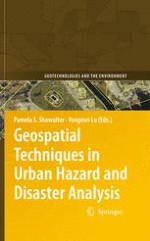2010 | OriginalPaper | Buchkapitel
16. Remote Sensing and GIS Data/Information in the Emergency Response/Recovery Phase
verfasst von : Michael E. Hodgson, Bruce A. Davis, Jitka Kotelenska
Erschienen in: Geospatial Techniques in Urban Hazard and Disaster Analysis
Verlag: Springer Netherlands
Aktivieren Sie unsere intelligente Suche, um passende Fachinhalte oder Patente zu finden.
Wählen Sie Textabschnitte aus um mit Künstlicher Intelligenz passenden Patente zu finden. powered by
Markieren Sie Textabschnitte, um KI-gestützt weitere passende Inhalte zu finden. powered by
